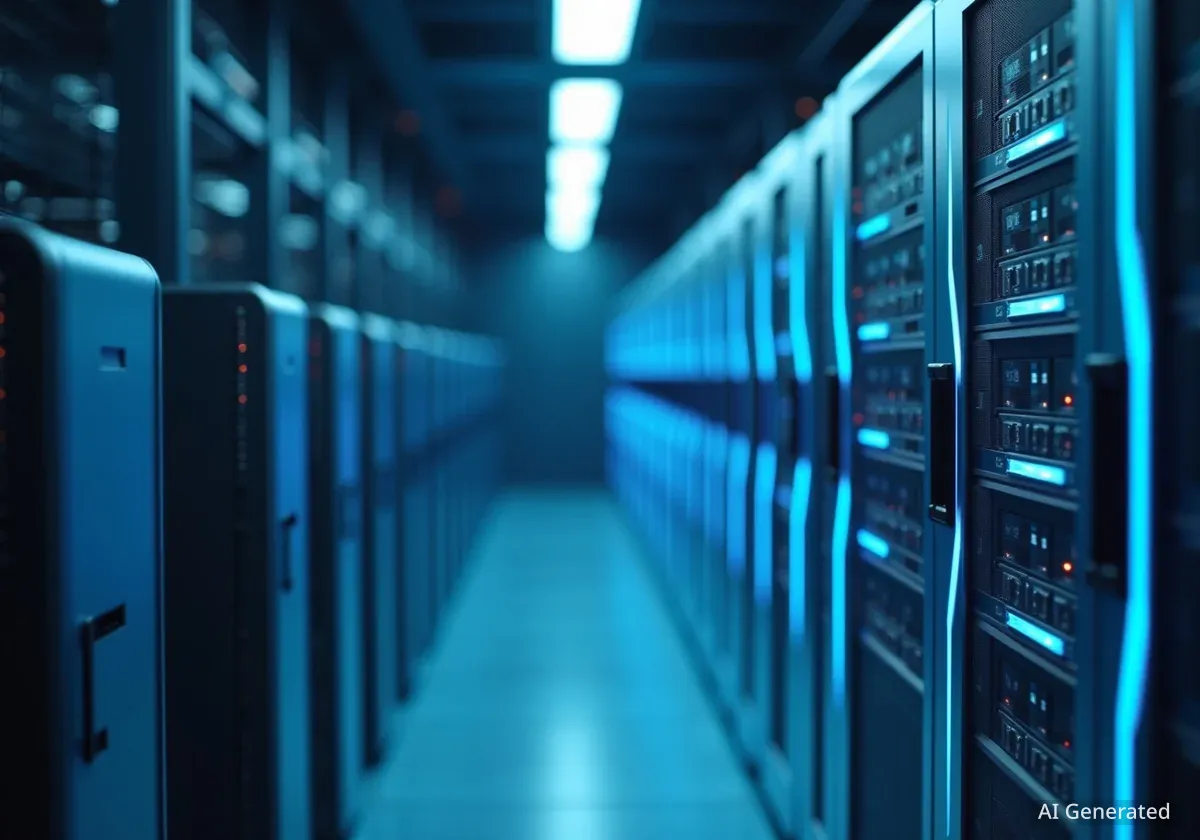Nvidia has accumulated a significant cash reserve, reaching $57 billion in cash and short-term investments. The company is now deploying this capital through a unique strategy of investing in key AI partners, a move that secures future demand for its advanced processors and supports the growth of the entire AI ecosystem.
This approach involves providing substantial financial backing to AI startups and cloud providers, who in turn use the funds to purchase Nvidia's hardware. This creates a self-reinforcing cycle that has drawn attention from market analysts, with some describing it as a form of circular financing. Major beneficiaries of this strategy include CoreWeave, Nscale, and most notably, OpenAI.
Key Takeaways
- Nvidia generated $112 billion in free cash flow over the last six quarters, with cash reserves now at $57 billion.
- The company is investing billions in AI partners like CoreWeave, Nscale, and OpenAI.
- These investments often result in the partner companies purchasing Nvidia's AI hardware, creating a feedback loop.
- A landmark commitment of up to $100 billion to OpenAI is aimed at building massive new data center infrastructure.
- This strategy helps Nvidia diversify its customer base beyond major cloud providers and ensures long-term demand for its products.
Managing Unprecedented Cash Flow
Nvidia's financial performance has been remarkable. Over the past 18 months, the company generated $112 billion in free cash flow. This has led to a rapid accumulation of capital, with its cash and short-term investments increasing for 11 consecutive quarters to a total of $57 billion.
Like other cash-rich technology giants such as Apple, Nvidia has faced the question of how to best utilize these funds. The company has already pursued traditional avenues, including significant share buybacks. It spent $58 billion on repurchases in the last six quarters and has authorized another $60 billion.
Regulatory Hurdles Limit Acquisitions
In the past, large-scale mergers and acquisitions were a common use for large cash reserves. However, the current regulatory environment makes such deals difficult. Nvidia experienced this firsthand with its failed attempt to acquire Arm Holdings between 2020 and 2022, which was blocked by regulators. This has pushed the company to explore alternative investment strategies.
Alongside buybacks, Nvidia continues to invest heavily in its core business. Research and development expenses in its most recent second quarter were up 39% compared to the previous year. Despite this spending, the company's cash continues to grow, prompting a more creative approach to capital deployment.
Cultivating New Customers and Markets
A central part of Nvidia's strategy is to actively create and support new customers for its high-demand AI servers. This approach reduces its dependency on a small number of large cloud computing companies, often called "hyperscalers," like Amazon Web Services and Microsoft Azure.
The CoreWeave Model
The first major example of this strategy was Nvidia's support for CoreWeave. In 2023, CEO Jensen Huang identified the small AI cloud provider, which at the time had just $16 million in annual revenue. By providing CoreWeave with early access to its AI servers, Nvidia helped it grow into a major player now valued at approximately $80 billion.
Nvidia's involvement goes beyond being a supplier. The company holds about a 5% equity stake in CoreWeave. More recently, Nvidia signed a $6.3 billion agreement to purchase any of CoreWeave's excess data center capacity. This deal acts as a financial backstop, giving lenders more confidence to fund CoreWeave's aggressive expansion plans.
A CoreWeave spokesperson stated, "What makes our relationship strong is execution. CoreWeave has built the scale, infrastructure, and technical expertise to be a reliable partner, which is why customers and suppliers choose to work with us."
Replicating Success with Nscale
Nvidia appears to be replicating this model in other regions. During a recent trip to the United Kingdom, Huang endorsed a new company called Nscale. Similar to CoreWeave in its early days, Nscale is a young company with limited revenue.
Rapid Growth and High Expectations
Nvidia participated in a $1.1 billion financing round for Nscale. During the announcement, Jensen Huang reportedly signed a bottle of scotch with the phrase "zero to 50 billion," signaling his high expectations for Nscale's future growth.
Nscale has already secured contracts with Microsoft and OpenAI for data center deployments in the U.K. and has plans for international expansion. This partnership demonstrates Nvidia's method of identifying promising startups and providing the capital and hardware necessary to turn them into significant customers.
The $100 Billion OpenAI Commitment
The most significant demonstration of Nvidia's investment strategy is its recent commitment of up to $100 billion to OpenAI. This massive investment is tied to OpenAI's ambitious plan to build 10 gigawatts of dedicated data center capacity for its future AI models.
The scale of this project is immense. Ten gigawatts of power is equivalent to the output of nine new nuclear reactors. OpenAI CEO Sam Altman believes this level of computing power will be necessary for developing next-generation artificial intelligence, and the company's current contracts with cloud providers are insufficient to meet this future demand.
The Circular Financing Dynamic
This arrangement is structured in a way that directly benefits both companies. Nvidia provides the capital, which OpenAI then uses to purchase Nvidia's AI hardware for its new data centers. In return for its investment, Nvidia receives shares in OpenAI, one of the world's leading AI startups. This structure ensures that Nvidia's investment capital flows back to it as revenue from equipment sales, while also giving it a stake in a key industry leader.
This deal effectively guarantees that OpenAI's vast new infrastructure will be built using Nvidia's technology, locking out competitors. It also solves a problem for both: OpenAI gets the massive capital it needs, and Nvidia secures a huge, long-term customer for its products.
An Investor of Last Resort for the AI Boom
The deals with CoreWeave, Nscale, and OpenAI highlight a broader strategy. Nvidia is positioning itself as the primary financial engine of the AI revolution. By using its enormous cash flow to fund the infrastructure build-out, the company ensures the AI boom continues and that it remains the primary beneficiary.
Analysts suggest this model could be extended to other capital-intensive AI startups, such as Elon Musk's xAI or Anthropic. These companies also require vast amounts of computing power but lack the cash flow to fund it themselves. Nvidia can step in, provide the investment, secure an equity stake, and guarantee a future customer.
According to D.A. Davidson analyst Gil Luria, Nvidia is effectively becoming the "investor of last resort" for the AI industry. This strategic use of capital not only fuels its partners' growth but also solidifies Nvidia's dominant position in the market for years to come.





